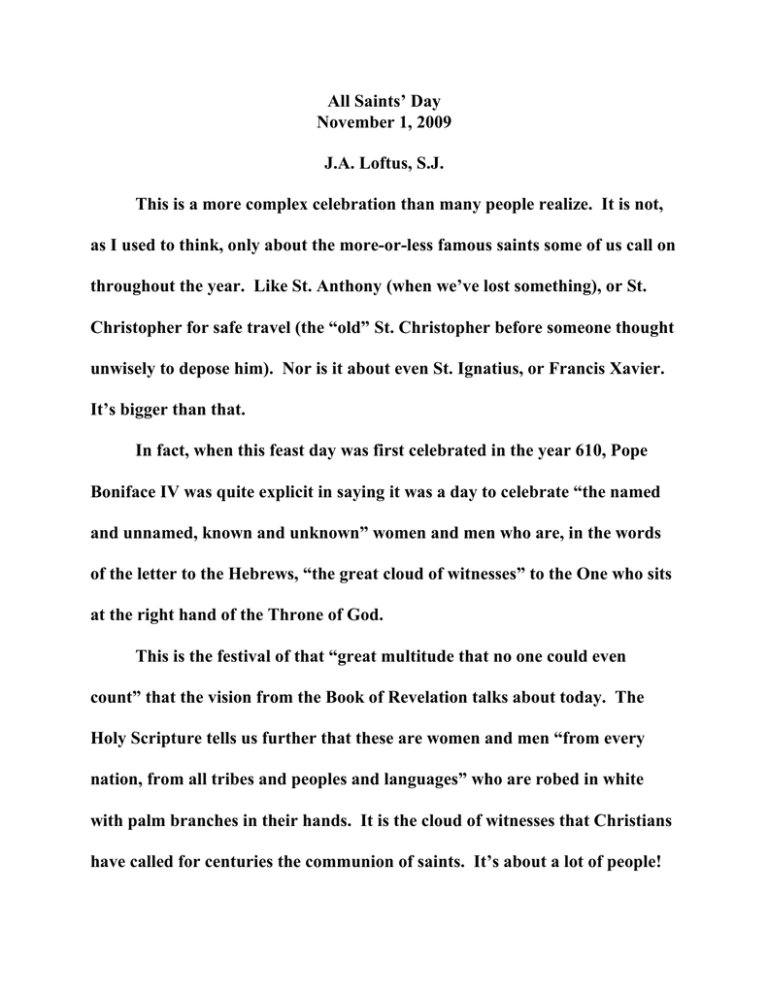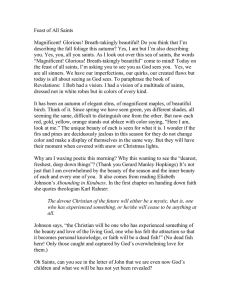All Saints’ Day November 1, 2009 J.A. Loftus, S.J.
advertisement

All Saints’ Day November 1, 2009 J.A. Loftus, S.J. This is a more complex celebration than many people realize. It is not, as I used to think, only about the more-or-less famous saints some of us call on throughout the year. Like St. Anthony (when we’ve lost something), or St. Christopher for safe travel (the “old” St. Christopher before someone thought unwisely to depose him). Nor is it about even St. Ignatius, or Francis Xavier. It’s bigger than that. In fact, when this feast day was first celebrated in the year 610, Pope Boniface IV was quite explicit in saying it was a day to celebrate “the named and unnamed, known and unknown” women and men who are, in the words of the letter to the Hebrews, “the great cloud of witnesses” to the One who sits at the right hand of the Throne of God. This is the festival of that “great multitude that no one could even count” that the vision from the Book of Revelation talks about today. The Holy Scripture tells us further that these are women and men “from every nation, from all tribes and peoples and languages” who are robed in white with palm branches in their hands. It is the cloud of witnesses that Christians have called for centuries the communion of saints. It’s about a lot of people! It’s about all the people who have tasted life and celebrated it. All those who have heard the Lamb saying: “I have come that you might have life and have it in abundance.” That’s who all the people are whom we honor today. But it’s even more complex. These are not all dead people! Many of these people are still alive and quite well, thank you. Only some have passed on. Sr. Elizabeth Johnson phrases it with her usual succinctness: “The first, irreplaceably important truth is that the communion of saints refers to the graced lives of human beings who are alive today.” Those who have tasted life and celebrate it! There are, most likely, some sitting here today. We are celebrating them. And everyone sitting here today is invited to join this extraordinary gathering. The very early Christians expressed this conviction about being a living holy community with an interesting vocabulary. They actually called each other “saints.” The Greek word for saint, hagioi, appears over 60 times in the New Testament, and it refers always to the living members of a community. It is even used by St. Paul in describing the community at Corinth, people who by our standards hardly embraced heroic virtue. They were rather notorious, St. Paul tells us, for their squabbling about power, engaging in strange sexual behavior, and constantly fighting about the liturgy. (Sounds familiar, doesn’t 2 it?) Yet these are the hagioi, the saints we celebrate today. Saints are ordinary people, just like us, who hear and respond with generosity to the invitation to become God’s friends and prophets (a phrase taken from the title of one of Johnson’s books). Some of these saints are remembered by name; most remain anonymous. Some belong to groups that have made an impact on public life throughout the centuries; all too many simply died untimely deaths or had their lives ruined in incidents of terror, war or mass destruction. But each of the saints in their own unique ways, in different times and places, struggled to be faithful–and to live life fully. They leave an imprint in the heritage of “life in the Spirit” that we inhabit even today (Johnson). They are still here witnessing to life in God. This feast is bigger than I was ever taught. It is about a lot of people, ordinary people, across all boundaries that would divide us: across time, race, culture, language, gender, sexual orientation, health or illness, even across the boundary of death. Let me again give Sr. Elizabeth a another word: “From generation to generation the great Spirit of God, Holy Wisdom herself, passes into holy souls and not so holy ones and makes them friends of God and prophets. We 3 who are alive today are bearers of this holiness, connected to each other around the world in all our differences.” All it takes to be part of this extraordinary multitude of saints approaching the living God is to hear again today’s gospel. We call it the Beatitudes, or the Sermon on the Mount. This gospel is the counter-intuitive, counter-cultural Jesus at his best–or at his worst, depending on your point of view. I’ve decided not to offer you one more homily on the Beatitudes. Most days I have to admit I don’t quite understand them. And on the days I think I do, it is more than a little scary. But you hear them the same as I do. They are an invitation–to us all! I close thinking of an old piece of advice from Dan Berrigan in his little book Ten Commandments for the Long Haul. He says: “About practically everything in the world, there’s nothing you can do. This is Socratic wisdom. However about a few things you can do something. Do it with a good heart.” And Dan’s final word: “You have to taste life before you can celebrate it.” Sometimes it’s difficult to be a saint, I guess. But maybe sometimes it’s easy. Today is our feast! Taste it. And, by all means, join, with hearty voices, 4 that complex chorus in the clouds... when those saints go marching in! Happy Feast Day! 5






